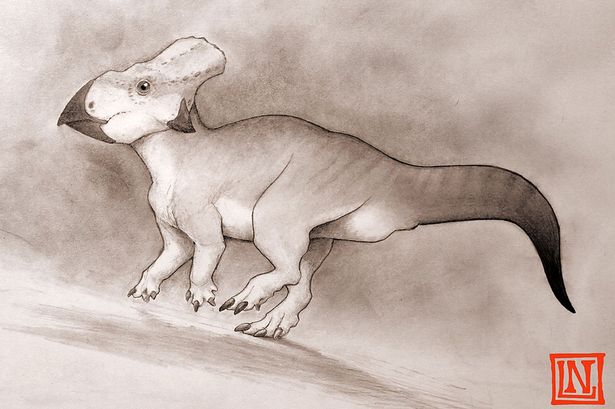Product Categories
Latest news
Contact us
- Tel: +86 813 2105845
- Fax: +86 813 2105845
- Mob: +86 13778532392
- Contact: Mr. Jacky
 info@dinosaurs-world.com
info@dinosaurs-world.com Jackydinosworld@gmail.com
Jackydinosworld@gmail.com Jackyyiming@gmail.com
Jackyyiming@gmail.com Jackyzengdinosaursworld
Jackyzengdinosaursworld
- Dinosaur find proves prehistoric America was split in half by diet choice

New discovery: Artist's impression of a dog-sized horned dinosaur which roamed eastern North America up to 100 million years ago
A rare horned dinosaur fossil shows species on North America’s east and west coasts ate differently.
The bone fragment reveals the dog-sized creature – from the eastern area of Appalachia – had teeth that curved downwards and outwards, and a more slender beak-like jaw than its western relatives, showing that their diets differed.
This adds to the theory that North America was split into two continents by water 66 to 100 million years ago, so dinosaurs on each side evolved separately.
Dr Nick Longrich, from the University of Bath’s Milner Centre for Evolution studied the specimen.
He said: “Each one of these island continents would have evolved its own unique dinosaurs, so there are probably many more species out there.”
 Study: Experts at the University of Bath think America may have been two separate continents.
Study: Experts at the University of Bath think America may have been two separate continents.
When the sea levels were very high and the landmasses across the Earth were very fragmented, is like looking at several independent experiments in dinosaur evolution.downward and outwards in a beak shape.
The jaw was also more slender than that of Ceratopsia found in western North America, suggesting the dinosaurs had different diets and evolved along distinct evolutionary paths.
“Just as many animals and plants found in Australia today are quite different to those found in other parts of the world, it seems that animals in the eastern part of North America in the Late Cretaceous period evolved in a completely different way to those found in the western part of what is now North America due to a long period of isolation,” Dr Longrich said.
“This adds to the theory that these two land masses were separated by a stretch of water, stopping animals from moving between them, causing the animals in Appalachia to evolve in a completely different direction, resulting in some pretty weird looking dinosaurs.
“Studying fossils from this period, when the sea levels were very high and the landmasses across the Earth were very fragmented, is like looking at several independent experiments in dinosaur evolution.
“At the time, many land masses - eastern North America, Europe, Africa, South America, India, and Australia - were isolated by water.
“Each one of these island continents would have evolved its own unique dinosaurs - so there are probably many more species out there to find.”
Ceratopsia is a group of plant-eating horned dinosaurs that lived in the Cretaceous period.
The fossil Dr Longrich studied comes from a smaller cousin of the better known Triceratops, the leptoceratopsids - about the size of a large dog.
His study, published in the journal Cretaceous Research, highlights it as the first fossil from a ceratopsian dinosaur identified from this period of eastern North America.

 2015-11-30
2015-11-30
Related news
 New dinosaur species help scientists fill in evolutionary gaps
New dinosaur species help scientists fill in evolutionary gaps Feathered everything: just how many dinosaurs had feathers?
Feathered everything: just how many dinosaurs had feathers? Dinosaur Fossil With Fleshy Rooster's Comb Is First of Its Kind
Dinosaur Fossil With Fleshy Rooster's Comb Is First of Its Kind Scientists finally decode how dinosaurs turned into birds and learned how to fly
Scientists finally decode how dinosaurs turned into birds and learned how to fly Dark matter may have killed the dinosaurs, claims scientist
Dark matter may have killed the dinosaurs, claims scientist New duck-billed dinosaur uncovered in Alaska, researchers say
New duck-billed dinosaur uncovered in Alaska, researchers say
- Contact Us
- Tel: +86 813 2105845
- Fax: +86 813 2105845
- Contact: Mr. Jacky
 info@dinosaurs-world.com
info@dinosaurs-world.com Jackydinosworld@gmail.com
Jackydinosworld@gmail.com Jackyyiming@gmail.com
Jackyyiming@gmail.com Jackyzengdinosaursworld
Jackyzengdinosaursworld
- Copyright @ 2009 - 2020 Zigong Dinosaurs World Science & Technology Co.,Ltd.

